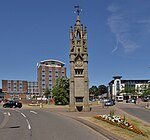Abbey Fields

Abbey Fields is a 68-acre (28 ha) park that is found in the centre of Kenilworth, Warwickshire, England. The park was once farmland belonging to St Mary's Abbey, which was dissolved in the middle of the sixteenth century and is now ruined. St Nicholas Church, with origins from the twelfth century, remains in the park. The park is now maintained by Warwick District Council and has a leisure-centre complex which includes indoor and outdoor swimming pools, five tennis courts and a large play area for children. Other features of the park include a cafe, the town's war memorial, and a museum charting the history of the abbey, located in the old barn. As well as these manmade attractions, there is to be found a natural lake and Finham Brook, a tributary of the River Sowe. The volunteer-run organisation Friends of Abbey Fields works with the district council to maintain the park. As the largest park in the town, it hosts a number of well-known events each year, such as the Lions Club show, the town carnival, bonfire night events and the Boxing Day charity duck race. It is also an orienteering venue used by the Midlands club Octavian Droobers.
Excerpt from the Wikipedia article Abbey Fields (License: CC BY-SA 3.0, Authors, Images).Abbey Fields
High Street,
Geographical coordinates (GPS) Address Nearby Places Show on map
Geographical coordinates (GPS)
| Latitude | Longitude |
|---|---|
| N 52.347 ° | E -1.583 ° |
Address
Swimming Pool
High Street
CV8 1LE , Abbey Fields
England, United Kingdom
Open on Google Maps







